Sponsored feature: Hyundai Kona - The best of both worlds
What do you do if you love cars but are also environmentally conscious? The answer is India’s first long-range electric SUV, the Hyundai Kona Electric.
Published On Aug 23, 2019 04:37:00 PM
12,838 Views
Follow us onI’m a confirmed auto buff. I can tell you everything about every car around and I’m intensely proud of my driving skills. In fact, my friends know that the best way to make me happy is to gift me scale models (since none of them can afford an actual one – yet), or tell me stuff about cars that I didn’t know (which is, of course, rather difficult, since I’m pretty much clued in all the time). But the thing is, I’m not your usual car enthusiast. Don’t get me wrong: I love powerful internal combustion engines, smashing-looking sedans and sportscars , the gorgeous music that emanates from their pipes, and the sheer convenience they offer. But, for the last couple of months, I’ve also realised that the future of the automobile is going to be electric. And how can it not be? Electric vehicles are an integral part of meeting global targets on climate change, and as an environment-conscious auto lover, that resonates strongly with me. I don’t use plastic, I don’t waste water, I recycle nearly everything I use, I conserve energy – so shouldn’t I be driving an electric car?
Over time and with lots of research, I’ve learnt that electric cars need not be boring, or crude, or cumbersome to both own and drive. Truth be told, despite the mass of data that points towards an electric tomorrow, I still needed some convincing about the capabilities of a solidly engineered, hassle-free electric car. That was when I met – and spent a lot of time in Delhi with – the Hyundai Kona, the country’s first long-range electric SUV.
Designed by the future
I could tell you a lot about the Hyundai Kona Electric, but let me present you with some solid, incontrovertible facts first. With the Kona Electric, range anxiety does not come into the picture at all. In the tests conducted by the Automotive Research Association of India, the Kona Electric achieved a staggering range of 452km. Extrapolate that to real-word conditions, and you would still get a tidy, reassuring figure.

Here’s fact No 2: the Kona Electric looks and feels like no other EV you’ve been in before. It looks funky and futuristic, has a nice, wide stance and sweet 17-inch wheels. I especially love the slim LED DRLs. Moral of the story? Hyundai’s electric SUV looks cool. You won’t be disappointed with the interiors, either. The cabin is commodious, looks contemporary and feels premium. You have leather seats, a soft-touch dashboard and a leatherwrapped steering wheel with audio and Bluetooth controls. The infotainment system has Android Auto and Apple CarPlay connectivity, and there’s wireless charging as well. In short, I can’t think of anything I’d miss if I bought the Hyundai Kona Electric.
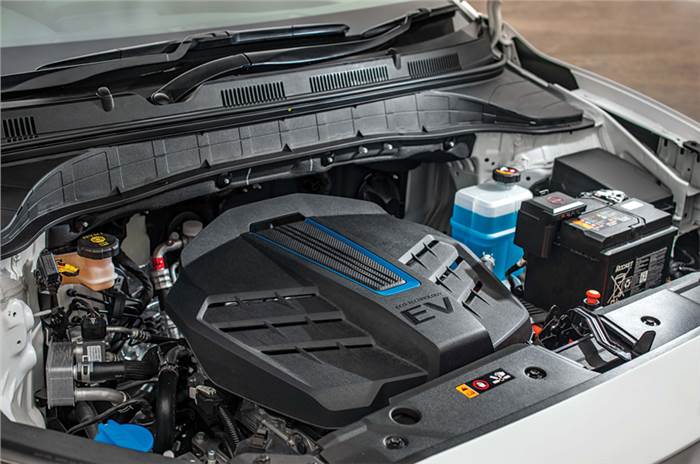
Which brings us to fact No 3, and that is, the Kona Electric can really go. We will come to that in a bit, but let me just give you an idea of its capabilities. The Kona Electric is equipped with a 136kp permanent-magnet-synchronous electric motor powered by a high-voltage 39.2kWh advanced lithium-ion polymer battery equipped with liquid cooling tech. Thanks to the 395Nm of torque that is sent to the front wheels, you can go from 0-100kph in a remarkably quick 9.7sec. And wait – in case you want your electric car to have fully automatic temperature control and an electric sunroof, Hyundai’s got you covered. All of this is well and good, but to see what the Kona Electric is like to drive in the city and in real conditions, let’s get behind the wheel.
City slicker
Here’s the thing. Driving the Kona Electric in and around the city is so hassle-free that you forget it is differently engineered from all the cars around it. I took it for a long spin in Delhi, around Janpath, Connaught Place, Pandara Road, and out on the highway at various times during the day. And I have to report that it was an extremely pleasant, often surprising, experience – one that has made me look at electric cars in a different way.

The first thing that hits you about the Kona Electric is the way in which it responds to your inputs. It’s remarkably responsive, and adapts to the driver’s needs in an intuitive manner. So, if you are merely heading out for a leisurely cruise to get some coffee, it will deliver a smooth-as-butter experience. But in case you are in the mood for fun, it will rise to the occasion and dish out exhilarating acceleration. Simply put, you can dip in and out of traffic, pull safe, measured overtaking manoeuvres, blast past slow-moving trucks, and return home feeling like a cat. Let me also add here that the Kona Electric’s motor-driven power steering is specially calibrated for precision and rapid adjustments. Hyundai has worked on the Kona Electric’s suspension so that the car’s ride is firm but comfortable, and most importantly, it can tackle anything Indian roads can throw at it. What about ground clearance? The Kona Electric’s ground clearance has been upped to 172mm from the 158mm of the model sold internationally.

I tinker around with the Kona Electric’s four modes – Eco Plus, Eco, Comfort and Sport – and observe the way the EV reacts. As is evident from the terminology, Eco Plus is where regenerative braking (which helps charge the batteries when you slow down) is at its most active. So, if you are looking to conserve some juice, Eco Plus is the way to go, and if you want to go bam! simply switch to Sport and show other cars on the road the Kona Electric’s fetching LED tail-lamps. Regarding charging, every unit will be sold with two chargers – a 2.8kW portable charger and an AC wall-box charger. The portable charger can be plugged into any regular three-pin 15A socket, and can deliver enough for 50km in under 3hr, while the AC wall-box charger (7.2kW) can deliver the same within an hour. The AC wall-box charger, which can be installed at your home or workplace, tops-up the Kona Electric in about 6hr. The manufacturer is also working on a DC fast-charging option that can deliver an 80 percent charge in just 57min!
One-track mind
I’d never thought I’d get an opportunity to drive an electric car at the Buddh International Circuit (BIC). That line of thought is justifiable considering the kind of EVs that we have seen in India. But the Kona Electric is obviously different, and that became very apparent, as I put the pedal to the metal at the BIC. The instantaneous shove of torque pinned me back into my seat and within a few seconds, I was in triple-digit territory. Thankfully, it was a safe and controlled environment at the 5.14km-long BIC, and I was able to unleash all the horses on the arrow-straight stretch to reach 180kph without much effort!
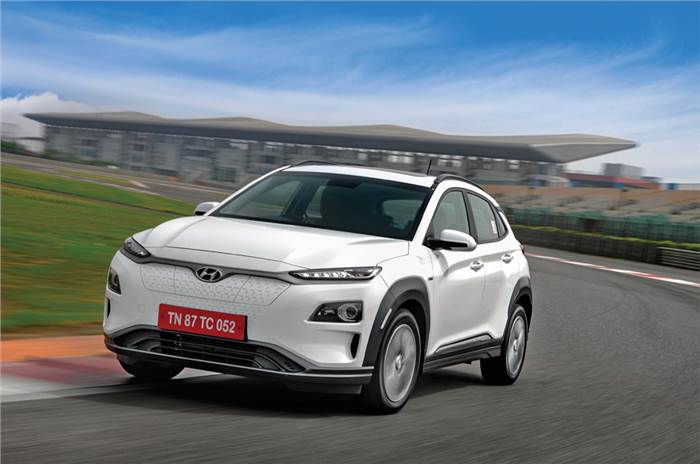
The dynamics, too, were spot-on, with the low-set battery pack placed under the floor, decreasing the overall centre of gravity of the Kona Electric and allowing for sharp turns into corners. There’s minimal body roll, and braking performance is optimal with regenerative braking converting most of the kinetic energy generated by the brakes into electrical charge and replenishing the battery. The Kona Electric’s crisp and beautifully legible digital instrument cluster still showed a total range of 118km, even after I’d driven the car hard at the BIC. Before taking the wheel to complete three laps of the race circuit, I had started off with a range of 124km. Now that’s really eco-friendly, isn’t it? Here’s what I learnt from my experience with the Hyundai Kona Electric: it is possible to deliver the best of both worlds. It is possible to be both environment-friendly and produce a driving – and an all-round – experience that can impress even petrolheads like this writer. This, ladies and gentlemen, is a car designed by the future, and I, for one, am fully charged up by it.
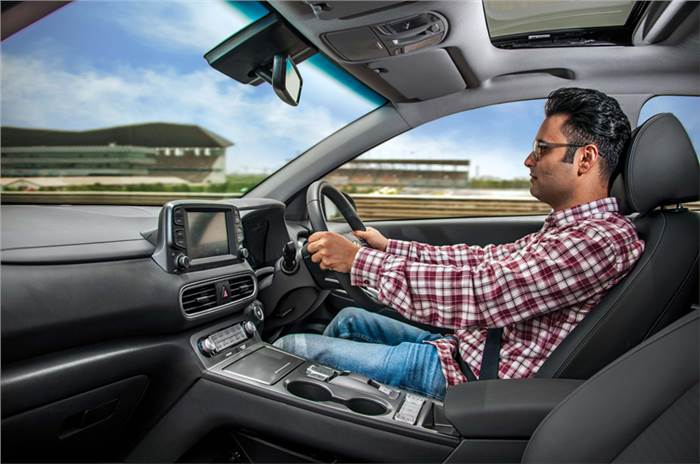
| Four fast facts about the Hyundai Kona Electric | |
|---|---|
| 1 | In the tests conducted by the ARAI, the Hyundai Kona Electric achieved a staggering range of 452km. |
| 2 | Thanks to the 395Nm of torque sent to the front wheels, you can go from 0-100kph in a remarkably quick 9.7sec. |
| 3 | The Kona Electric comes with a warranty for three years and unlimited kilometres, along with a warranty for eight years and up to 1,60,000km for its high-voltage battery. |
| 4 | The Kona Electric’s ground clearance has been upped to 172mm from 158mm of the model sold internationally. |
Copyright (c) Autocar India. All rights reserved.


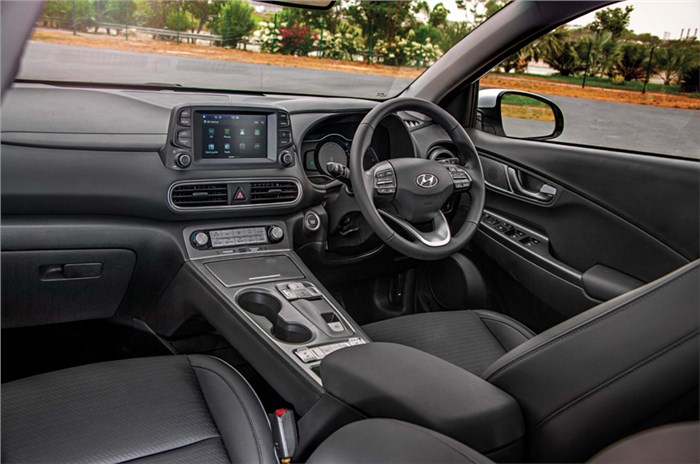
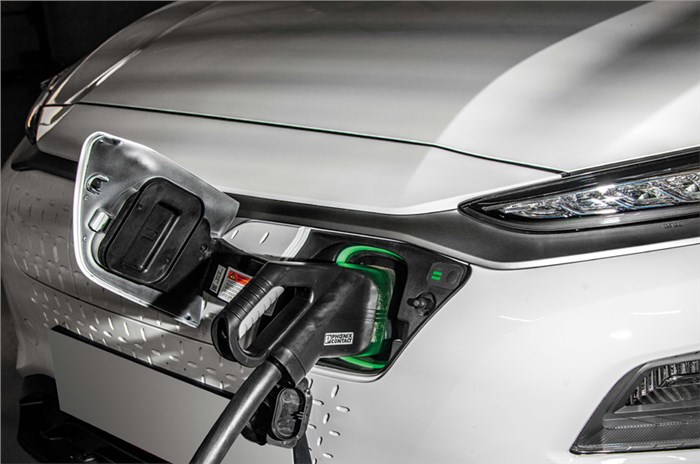
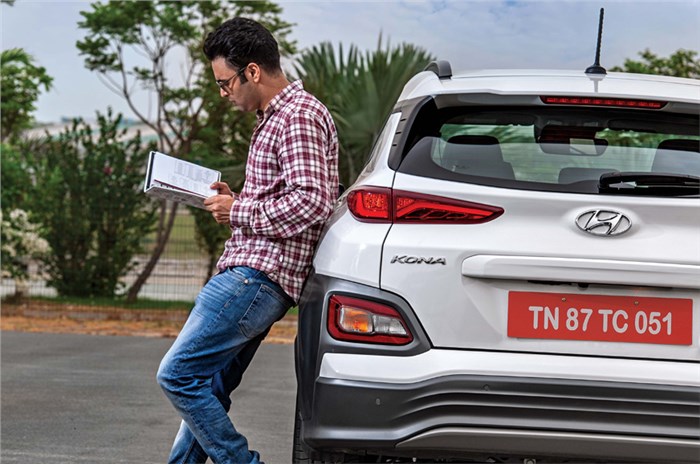


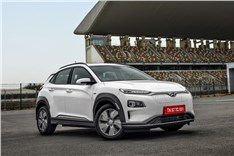

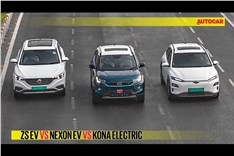



Comments
Member Login
Personal Details
No comments yet. Be the first to comment.